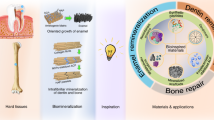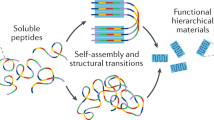Abstract
The functional design of hard tissues by structural control during biomineralization has attracted attention as a novel method for the development of next-generation functional materials that are based on living organisms. In previous studies, the mechanisms of formation and crystal growth of inorganic matter during mineralization have been investigated. However, these mechanisms have yet to lead to the establishment of a principle that can collectively explain the phenomenon occurring during this process. In this review, the advantages associated with the molecular design of peptides as multifunctional templates for mineralization are initially described. Subsequently, the mechanisms of CaCO3 nucleation and selective crystal growth achieved under biomimetic mineralization conditions using the designed peptide templates are discussed. Finally, the functional design of peptide–inorganic hybrid materials based on structural control and the use of a mineralization method that can be applied in the engineering and medical fields are considered from the viewpoint of the molecular properties of the peptides. Overall, the described studies provided significant breakthroughs for the improvement of the functionalities of organic–inorganic hybrid materials based on the use of biomineralization-inspired environmentally friendly processes.
This is a preview of subscription content, access via your institution
Access options
Subscribe to this journal
Receive 12 print issues and online access
$259.00 per year
only $21.58 per issue
Buy this article
- Purchase on Springer Link
- Instant access to full article PDF
Prices may be subject to local taxes which are calculated during checkout








Similar content being viewed by others
References
Cantaert B, Kuo D, Matsumura S, Nishimura T, Sakamoto T, Kato T. Use of amorphous calcium carbonate for the design of new materials. ChemPlusChem. 2017;82:107–20.
Dey A, With G, Sommerdijk NAJM. In situ techniques in biomimetic mineralization studies of calcium carbonate. Chem Soc Rev. 2010;39:397–409.
Addadi L, Raz S, Weiner S. Taking advantage of disorder: amorphous calcium carbonate and its roles in biomineralization. Adv Mater 2003;15:959–70.
Oosterlaken BO, Vena MP, With G. In vitro mineralization of collagen. Adv Mater 2021;33:2004418.
Tanahashi M, Matsuda T. Surface functional group dependence on apatite formation on self-assembled monolayers in a simulated body fluid. J Biomed Mater Res. 1997;34:305–15.
Cai Y, Yao J. Effect of proteins on the synthesis and assembly of calcium phosphate nanomaterials. Nanoscale 2010;2:1842–8.
Nguyen L, Döblinger M, Liedl T, Heuer-Jungemann A. DNA-origami-templated silica growth by sol–gel chemistry. Angew Chem Int Ed. 2019;58:912–6.
Otsuka K, Murai K. Silica mineralization on anisotropic gelatin-hydrogel scaffolds. CrystEngComm. 2022;24:1917–23.
Tong Z, Jiang Y, Yang D, Shi J, Zhang S, Liu C, et al. Biomimetic and bioinspired synthesis of titania and titania-based materials. RSC Adv. 2014;4:12388–403.
Shchipunov Y, Postnova I. Cellulose mineralization as a route for novel functional materials. Adv Funct Mater. 2018;28:1705042.
Hartgerink JD, Beniash E, Stupp SI. Self-assembly and mineralization of peptide-amphiphile nanofibers. Science. 2001;294:1684–8.
Qi Y, Cheng Z, Ye Z, Zhu H, Aparicio C. Bioinspired mineralization with hydroxyapatite and hierarchical naturally aligned nanofibrillar cellulose. ACS Appl Mater Interfaces. 2019;11:27598–604.
Nonoyama T, Ogasawara H, Tanaka M, Higuchi M, Kinoshita T. Calcium phosphate biomineralization in peptide hydrogels for injectable bone-filling materials. Soft Matter. 2012;8:11531–6.
Dey A, Bomans PHH, Müller FA, Will J, Frederik PM, With G, et al. The role of prenucleation clusters in surface-induced calcium phosphate crystallization. Nat Mater 2010;9:1010–4.
Nonoyama T, Kinoshita T, Higuchi M, Nagata K, Tanaka M, Sato K, et al. TiO2 synthesis inspired by biomineralization: control of morphology, crystal phase, and light-use efficiency in a single process. J Am Chem Soc. 2012;134:8841–7.
Liu C, Yang D, Jiao Y, Tian Y, Wang Y, Jiang Z. Biomimetic synthesis TiO2–SiO2–Ag nanocomposites with enhanced visible-light photocatalytic activity. ACS Appl Mater Interfaces. 2013;5:3824–32.
Sun S, Mao LB, Lei Z, Yu SH, Cölfen H. Hydrogels from amorphous calcium carbonate and polyacrylic acid: bio-inspired materials for “mineral plastics”. Angew Chem Int Ed. 2016;55:11765–9.
Nonoyama T. Robust hydrogel–bioceramics composite and its osteoconductive properties. Polym J. 2020;52:709–16.
Murai K, Inagaki K, Hiraoka C, Minoshima S, Kinoshita T, Nagata K, et al. Mineralization of magnetic nano-tape in self-organized nanospace composed of nucleopeptides and peptides. CrystEngComm. 2019;21:3557–67.
Palomo C, Oiarbide M, Landa A, González-Rego MC, García JM, González A, et al. Design and synthesis of a novel class of sugar-peptide hybrids: C-linked glyco β-amino acids through a stereoselective “acetate” mannich reaction as the key strategic element. J Am Chem Soc. 2002;124:8637–43.
Murai K, Higuchi M, Kuno T, Kato K. Silica mineralization by a peptide template having a high charge relay effect. ChemPlusChem. 2014;79:531–5.
Murai K, Isobe H, Tezuka A, Nishio K. Continuous variation of secondary structural contents of interfacial peptides induced by hydrogel fusion. Langmuir. 2022;38:3032–9.
Murai K, Kinoshita T, Nagata K, Higuchi M. Mineralization of calcium carbonate on multifunctional peptide assembly acting as mineral source supplier and template. Langmuir. 2016;32:9351–9.
Miyamoto H, Miyashita T, Okushima M, Nakano S, Morita T, Matsuhiro A. A carbonic anhydrase from the nacreous layer in oyster pearls. Proc Natl Acad Sci USA. 1996;93:9657–60.
Murai K, Higuchi M, Kinoshita T, Nagata K, Kato K. Calcium carbonate biomineralization utilizing a multifunctional β-sheet peptide template. Chem Commun. 2013;49:9947–9.
Murai K, Funamizu Y, Ogura T, Nishio K. Bioinspired mineralization of calcium carbonate in peptide hydrogel acting as a multifunctional three-dimensional template. J Asian Ceram Soc. 2021;9:771–81.
Murai K, Yamamoto Y, Kinoshita T, Nagata K, Higuchi M. Self-bonding and the electrochemical properties of silica-coated nanowires composed of cobalt-coordinated peptide bundles. J Mater Chem B. 2017;5:5539–48.
Tsuchiya R, Murai K. Peptide-templated biomineralization of titanium dioxide toward improved light absorption and photodegradation activity. Mol Syst Des Eng. 2022;7:1602–10.
Yaghoubi H, Li Z, Chen Y, Ngo HT, Bhethanabotla VR, Joseph B, et al. Toward a visible-light-driven photocatalyst: the effect of midgap-states-induced energy gap of undoped TiO2 nanoparticles. ACS Catal. 2015;5:327–35.
Umrao S, Abraham S, Theil F, Pandey S, Ciobota V, Shukla PK, et al. A possible mechanism for the emergence of an additional band gap due to a Ti–O–C bond in the TiO2-graphene hybrid system for enhanced photodegradation of methylene blue under visible light. RSC Adv. 2014;4:59890–901.
Yu Y, Wu K, Wang D. Dye-sensitized solar cells with modified TiO2 surface chemical states: the role of Ti3+. Appl Phys Lett. 2011;99:192104.
Zhang X, Tian H, Wang X, Xue G, Tian Z, Zhang J, et al. The role of oxygen vacancy-Ti3+ states on TiO2 nanotubes’ surface in dye-sensitized solar cells. Mater Lett. 2013;100:51–53.
Acknowledgements
This research was supported by Grant-in-Aid for JSPS Fellow (14J06876), Grant-in-Aid for Young Scientists (Grant Nos. 16K18250 and 20K15340) from the Japan Society for the Promotion of Science and the Foundation for the Promotion of Ion Engineering. I would like to thank Editage (www.wditage.com) for English language editing.
Author information
Authors and Affiliations
Corresponding author
Ethics declarations
Conflict of interest
The author declares no competing interests.
Additional information
Publisher’s note Springer Nature remains neutral with regard to jurisdictional claims in published maps and institutional affiliations.
Supplementary information
Rights and permissions
Springer Nature or its licensor (e.g. a society or other partner) holds exclusive rights to this article under a publishing agreement with the author(s) or other rightsholder(s); author self-archiving of the accepted manuscript version of this article is solely governed by the terms of such publishing agreement and applicable law.
About this article
Cite this article
Murai, K. Development of peptide–inorganic hybrid materials based on biomineralization and their functional design based on structural controls. Polym J 55, 817–827 (2023). https://doi.org/10.1038/s41428-023-00783-8
Received:
Revised:
Accepted:
Published:
Issue Date:
DOI: https://doi.org/10.1038/s41428-023-00783-8



